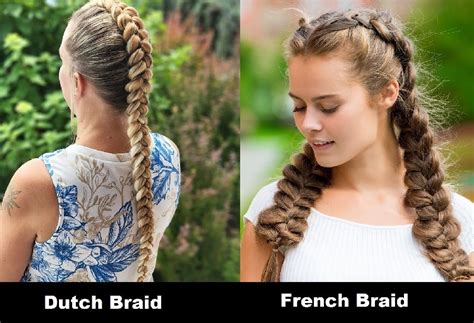Dutch Braid: The Inside-Out Charmer
A History of Dutch Braiding
Dutch braids, also known as inside-out braids, have their origins in the Netherlands, where they were traditionally worn by married women. The name “Dutch braid” is a relatively recent adaptation, with the term “inside-out” more accurately describing the technique.

Dutch Braid Technique
Dutch braids are created by taking three sections of hair from the crown of the head, crossing the right section under the middle section, and then crossing the left section under the middle section. This process is repeated while adding new hair from the sides, gradually weaving it into the braid. The result is a raised, voluminous braid that sits close to the scalp.
French Braid: The Classic Beauty
A French Legacy
French braids, the epitome of hair elegance, have been a timeless fashion statement for centuries. Originating in France during the Middle Ages, these braids were initially known as “French plaits.” The term “French braid” became popular in the 20th century, establishing this hairstyle as a global icon.
French Braid Technique
French braids are created similarly to Dutch braids, but with a key difference: the sections of hair are crossed over the middle section instead of under it. This technique creates a flatter, wider braid that sits more loosely on the head.
Comparing Dutch and French Braids
| Feature | Dutch Braid | French Braid |
|---|---|---|
| Appearance | Raised, voluminous | Flatter, wider |
| Technique | Sections crossed under the middle | Sections crossed over the middle |
| Position | Close to the scalp | Loose on the head |
| Difficulty | Slightly more challenging | Relatively easier |
Choosing the Right Braid for Your Style
Dutch braids exude an intricate and regal charm, perfect for formal occasions or to add volume to thin hair. In contrast, French braids offer a classic and effortless elegance, suitable for everyday wear or special events alike.
Pain Points and Motivations
Dutch Braids:
- Pain point: Tightening can cause discomfort for some.
- Motivation: The voluminous, crown-like appearance enhances hair height and adds visual interest.
French Braids:
- Pain point: Loose weaving can lead to hair falling out of the braid.
- Motivation: The versatility allows for both formal and casual styling, while the flat profile complements a variety of face shapes.
Common Mistakes to Avoid
Dutch Braids:
- Over-tightening: Causes pain and breaks hair.
- Inconsistent weaving: Results in uneven braid texture.
French Braids:
- Loose weaving: Allows hair to slip out.
- Over-brushing: Damages hair texture and creates frizz.
Step-by-Step Approach
Dutch Braid
- Start with slightly damp hair and brush through to remove tangles.
- Divide hair into three equal sections at the crown.
- Cross the right section under the middle section, then cross the left section under the new middle section.
- Pick up a small section of hair from the right side and add it to the left section.
- Cross the new left section under the middle section.
- Repeat steps 4 and 5 on the left side, adding hair from the opposite side.
- Continue braiding and adding hair from the sides until you reach the nape of the neck.
- Secure the braid with an elastic band.
French Braid
- Follow steps 1 and 2 of the Dutch braid method.
- Cross the right section over the middle section, then cross the left section over the new middle section.
- Pick up a small section of hair from the right side and add it to the left section.
- Cross the new left section over the middle section.
- Repeat steps 3 and 4 on the left side, adding hair from the opposite side.
- Continue braiding and adding hair from the sides until you reach the nape of the neck.
- Secure the braid with an elastic band.
The Future of Braiding: Hybrid Innovations
The world of braiding is constantly evolving, with new techniques and styles emerging. One exciting innovation is the hybrid braid, which combines elements of both Dutch and French braids. This approach allows for endless customization and opens up new possibilities for hair styling.
Conclusion
Whether you prefer the regal Dutch braid or the timeless French braid, both styles offer distinct charms. Understanding the differences and techniques involved will help you choose the perfect braid for any occasion. As the art of braiding continues to innovate, hybrid braids and other novel creations promise to push the boundaries of hair styling.
